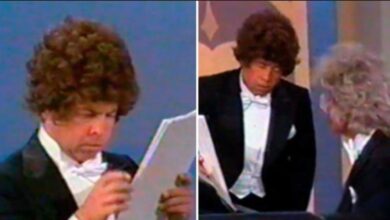Ricky Nelson’s “Hello Mary Lou” Bridges Rockabilly and Pop Stardom in 1961
Released in 1961 as the B-side to “Travelin’ Man,” Ricky Nelson’s “Hello Mary Lou” quickly proved itself more than a secondary track—it became one of the singer’s signature hits and an enduring staple of early 1960s rock and roll. With its cheerful rhythm, slick guitar licks, and smooth vocals, the song charted on the Billboard Hot 100 and found lasting life across multiple generations. It not only showcased Nelson’s maturing sound but also helped define the clean-cut crossover appeal of rockabilly in an era on the cusp of change.
By the time he recorded “Hello Mary Lou,” Ricky Nelson was already a household name. Born into fame through the family’s popular radio and television series, The Adventures of Ozzie and Harriet, Ricky evolved from teen idol to a respected musician. Unlike many of his peers who faded as musical tastes shifted, Nelson’s ability to blend country sensibilities with the rising tide of rock and roll allowed him to remain relevant. His deep admiration for artists like Carl Perkins and Elvis Presley added authenticity to his polished image.
The song itself was penned by Gene Pitney, who would later enjoy his own success as a recording artist. It’s said that Pitney originally wrote “Hello Mary Lou” as a nod to the archetypal American girl-next-door. With its simple lyrics—“Hello Mary Lou, goodbye heart”—the tune captures the swift intensity of a teenage crush. Nelson’s recording, enhanced by James Burton’s unforgettable guitar work, infused the lyrics with irresistible charm and confidence.
Produced by Joe Johnson and arranged by Jimmie Haskell, the recording featured a lean yet punchy arrangement. James Burton’s twangy, finger-picked guitar introduction instantly commands attention, often cited as one of the most iconic intros of early rock. Nelson’s vocal delivery—measured, breezy, and effortlessly melodic—gave the song a cool sophistication. Clocking in under two minutes, the track was concise yet complete, a testament to the power of tight songwriting and production.
Despite being the B-side to the massive hit “Travelin’ Man,” “Hello Mary Lou” charted on its own merits, reaching No. 9 on the Billboard Hot 100. In the UK, it charted even higher, landing at No. 2 and cementing Nelson’s international popularity. Its success demonstrated Nelson’s appeal wasn’t limited to ballads or teen-oriented pop; he had true range as a rockabilly performer with commercial clout.
Culturally, the song came at a pivotal time. 1961 was the year before the Beatles exploded onto the scene, and “Hello Mary Lou” stood as a bright example of American pop music’s transition from the 1950s crooner era into something more upbeat and electrified. It bridged the innocent optimism of the Eisenhower years with the increasingly bold youth movement of the 1960s. Its sunny disposition, accessible melody, and rockabilly swagger gave it multi-generational appeal.
For Nelson, the song became an important cornerstone in his career. While “Travelin’ Man” may have been the headline act, “Hello Mary Lou” allowed Nelson to shed some of the “TV star” image and earn credibility as a recording artist. It fueled interest in his live shows, particularly his performances with James Burton and his tight backing band, and expanded his audience beyond just the teenage demographic.
The influence of “Hello Mary Lou” rippled throughout the rock and country music landscape. Many artists admired its blend of country twang and pop polish, and it contributed to the development of country-rock years later. The Byrds, Poco, and the Eagles would all explore similar fusions, but Nelson’s early work paved the way. The song also stood as a blueprint for how to craft a commercially viable rockabilly track without sacrificing authenticity.
Not surprisingly, the song has been covered many times over the years. Creedence Clearwater Revival included a version on their 1972 Live in Europe album, injecting it with a swamp-rock feel. Queen guitarist Brian May has cited James Burton’s guitar work on “Hello Mary Lou” as a formative influence. The song’s timeless energy has also made it a favorite among rockabilly revivalists and cover bands worldwide.
In Nelson’s personal timeline, “Hello Mary Lou” coincided with a period of immense success and creative stability. He was recording consistently, performing live with a seasoned band, and developing a musical identity that would continue into his later ventures with the Stone Canyon Band in the country-rock era. The song reflected Nelson’s dual nature: one foot in television’s wholesome spotlight, the other planted firmly on the live stage with electric guitar in hand.
Decades later, “Hello Mary Lou” remains one of the most instantly recognizable hits of its time. Its inclusion in countless oldies compilations, film soundtracks, and jukebox rotations keeps it firmly rooted in the cultural memory. Unlike many hits from the early ’60s that feel dated, its crisp production and vibrant performance still resonate.
The track also influenced how artists approached B-sides. In an era where singles were king, Nelson’s ability to turn a B-side into a classic demonstrated that there was artistic and commercial value on both sides of the vinyl. It set a precedent that many future artists would follow—using B-sides to showcase different shades of their talent.
Though Ricky Nelson passed away tragically in a 1985 plane crash, songs like “Hello Mary Lou” endure as vibrant reminders of his talent and legacy. Posthumously, he was inducted into the Rock and Roll Hall of Fame in 1987, and his influence is still heard in the work of artists who bridge pop accessibility with country storytelling.
In the end, “Hello Mary Lou” is more than a catchy tune—it’s a snapshot of an artist mastering his voice at a critical point in pop music’s evolution. It remains a joyful, infectious gem that perfectly captures Ricky Nelson’s blend of style, sincerity, and rockabilly cool—a lasting testament to his place in music history.





